
The greenback flounder is a righteye flounder of the genus Rhombosolea, found around southern Australia and New Zealand.
Clathrina ceylonensis is a species of calcareous sponge from Sri Lanka. The species name is derived from Ceylon, the former name of Sri Lanka.
Arturia dubia is a species of calcareous sponge in the genus Arturia from Australia. The species was first described as Leucosolenia dubia by Arthur Dendy in 1891. The name is derived from Dendy's uncertainty about the validity of the species, believing his specimens could, in fact, represent juvenile Leucosolenia cavata.
Ascandra izuensis is a species of ssea sponge in the family Clathrinidae. The species is named after the Izu peninsula where the holotype was collected.
Clathrina mutsu is a species of calcareous sponge from Japan. The species is named after the type locality, Mutsu Bay
Borojevia paracerebrum is a species of calcareous sponge from Mexico. The species is named after its similarity to Borojevia cerebrum.

Xanthodaphne membranacea is a species of sea snail, a marine gastropod mollusk in the family Raphitomidae.
Cancelloxus elongatus, the whiteblotched klipfish, is a species of clinid found in subtropical waters of the Atlantic Ocean along the South African coast. It prefers sandy habitats with nearby rocks at depths of from 10 to 25 metres. It can reach a maximum length of 5 centimetres (2.0 in) TL. This species preys primarily on zoobenthos.
Citrus micrantha is a species of wild citrus from the papeda group, native to southern Philippines, particularly islands of Cebu and Bohol. Two varieties are recognized: small-flowered papeda, locally known as biasong, and small-fruited papeda or samuyao.

Arturia is a genus of calcareous sponge in the family Clathrinidae which contains 14 species. It is named after Arthur Dendy, a prominent researcher of calcareous sponges. It was renamed Arturia in 2017 because the name Arthuria was already assigned to a genus of molluscs.
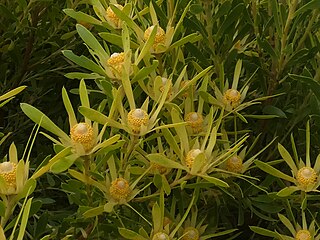
Leucadendron coniferum, also known at the dune conebush, is an evergreen, dioecious shrub or small tree of up to 4 m (13 ft) high, that has been assigned to the family Proteaceae. It has a whorl of conspicuous yellow leaves subtending the flowerheads. The flowers can be found in August and September. It grows in sandy soils near the coast of the Western Cape province of South Africa.

Leucospermum gerrardii is an evergreen, mat-forming shrub of mostly about 30 cm (12 in) high and up to 1 m (3.3 ft) in diameter, with branches originating from an underground rootstock. It has narrow leaves, sometimes with three or four teeth near the tip, and prominent, raised, netted to parallel veins. The flower heads are egg-shaped about 5 cm (2 in) in diameter and consist of at first yellow, later orange or scarlet perianths, and long styles reaching far beyond the perianth and together giving the impression of a pincushion. It is assigned to the family Proteaceae. It can be found in South Africa and Swaziland. It mostly flowers between September and November. The species is called dwarf pincushion or soapstone pincushion in English.
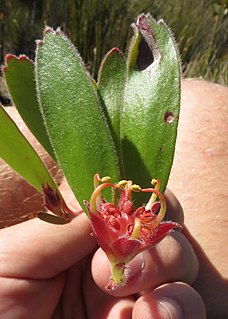
Leucospermum hamatum is mat-forming, evergreen shrublet of only about 10 cm (3.9 in) high, from the Proteaceae. It is usually 1–3 m (3.3–9.8 ft) in diameter, has long trailing stems and upright, inverted lance-shaped, entire leaves but for one to five shallow reddish bony teeth near the tip. Its small flower heads of 1½–2 cm (0.6–0.8 in) in diameter, consist of four to seven drab carmine-colored flowers that strongly curve back to the centre of the head. It mainly flowers from July till November and is pollinated by mice. It has been given the common name Ruitersbos pincushion.
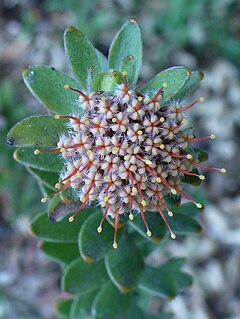
Leucospermum truncatulum is a slender, upright, evergreen, hardly branching shrub of up to 2 m (6 ft) high, with felty inverted egg-shaped to oval, leaves with entire margins of 1–2½ cm (0.4–1.0 in) long and ½–1 cm (0.2–0.4 in) wide. It has small globe-shaped, at first yellow, later pinkish flower heads of 1½–2 cm (0.6-0.8 in) in diameter, without a stalk, usually crowded with two to eight together near the end of the stems. It is known as oval-leaf pincushion in English, and patrysbos or kleinkopspeldekussing in Afrikaans. It is an endemic species of the south of the Western Cape province of South Africa, and flowers between August and December.

Leucospermum tomentosum is an evergreen, mostly spreading shrublet of approximately 75 cm (3 ft) high and up to 3 m (10 ft) in diameter, with alternately set, linear or narrowly spade-shaped, grey felty leaves, with one to three teeth near the tip. It has round, seated flower heads of 3–3½ cm (1.2–1.4 in) in diameter, occurring in groups of one to four, and consisting of deep yellow, very sweet scented flowers. It can survive the occasional wildfire because it regenerates from the underground rootstock. It is an endemic species that is restricted to a narrow strip along the Atlantic coast of the Western Cape province of South Africa. The species flowers between June and November. It is called Saldanha pincushion in English.

Leucospermum innovans is an upright evergreen shrub with many pustules growing on the lower branches, wedge-shaped leaves, and oval, flower heads that are yellow on the outside, but with scarlet stripes on the inside of the perianth claws, with long styles sticking far beyond the perianths, jointly giving the impression of a pincushion. It is called Pondoland pincushion or Transkei pincushion in English. Flowers occur on and off between July and December, but flowering peaks in September and October.
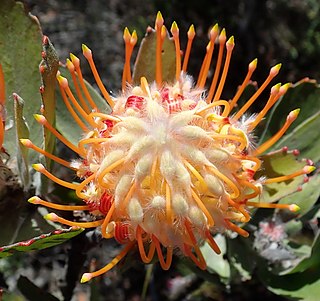
Leucospermum pluridens is a large upright evergreen shrub of up to 3 m (10 ft) high assigned to the family Proteaceae. It has leathery, oblong to wedge-shaped leaves of about 7½ cm long and 2½ cm wide, deeply incised near the tip with seven to ten teeth. It has initially yellow, later carmine coloured flower heads. The 2 cm long bracts have slender, recurved tips. From the center of the perianth emerge long styles that jointly give the impression of a pincushion. It is called Robinson pincushion in English and Robinson-kreupelhout in Afrikaans. Flowers can be found between September and December. It naturally occurs in the south of South Africa.

Leucospermum secundifolium is a low, evergreen shrub that grows along the ground, the tip of the branches slightly rising, which ihs been assigned to the family Proteaceae. It has narrowly elliptic leaves with a distinct leafstalk, and few-flowered and very small heads of 1–1½ cm (0.4–0.6 in) across. It is called stalked pincushion in English. The sweetly scented flower heads may be found around early December. It is an endemic species that only grows in a small area of the Western Cape province of South-Africa.

Lioglyphostoma rusum is an extinct species of sea snail, a marine gastropod mollusk in the family Pseudomelatomidae, the turrids and allies.
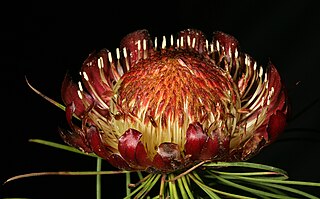
Protea pityphylla, also known as Ceres sugarbush or mountain rose, is a flowering shrub of the genus Protea, in the family Proteaceae. The plant is endemic to the southwestern Cape Region of South Africa.












